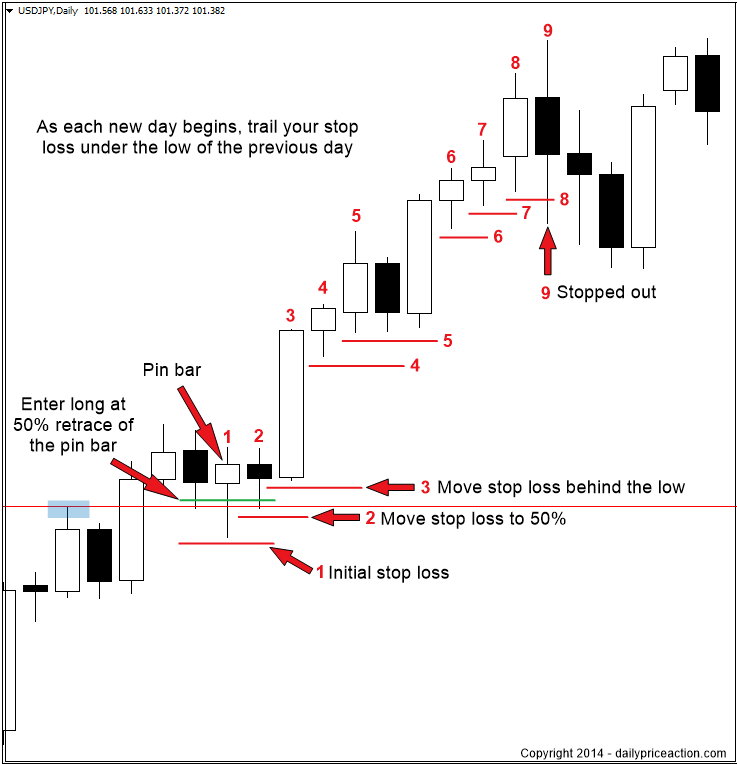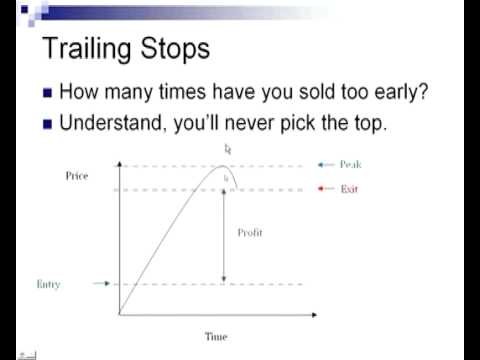Forex Trailing Stops Help Traders “Stop” Giving Back Gains
Post on: 18 Август, 2015 No Comment

Trailing stops let forex traders lock-in profits as well as reduce the overall risks of trades as they advance. A trailing stop protects profits by allowing a winning trade to remain open for as long as possible.
By choosing the right stop parameters, your mechanical trading system can manage trailing stops to maximize profits in any forex market. Trailing stops can ensure that youre able to stay in volatile-yet-winning trades long enough to escape with some profit.
A penny saved by tight trailing stops is a penny earned by volatility
For every pip that a well-designed trailing stop algorithm saves in avoiding premature stop-outs, a savvy trader can earn even more from price moves on volatility, as the trade continues favorably onward.
If you’re seeking better trading profits, it’s worthwhile to look at some ideas about how to develop a stop-loss and trailing-stop protocol that fits your own market, trading system and style.
What are “stop” orders?
A stop order is a type of conditional order which is executed once the currency reaches a specified stop price. The word “stop” in a forex order means the trader is focused on reducing risk.
A stop-loss or trailing stop order for a long forex position is set below the current market price. The stop for a short position is set above the current price.
Stops can be calculated and set at either a predetermined percentage or number of pips away from the current price.
In most marketplaces, a stop order guarantees an exit from the currency holding if the trigger price is touched, yet it doesn’t guarantee the actual fill price for that order when its executed.
Once the marketplace has traded at the stop price, that is, once the stop price is touched, the stop order becomes a market order to be filled at current price at the time when the order was triggered.
If the stop price is touched and the stop order changes to a market order, the trader is assured that the trade will be executed, but the exact price obtained at execution can vary according to liquidity, order size and other factors. Usually, the tighter the order is filled, the better the trade outcome.
Trailing stops
Trailing stops are a form of stop order set to follow along behind the price, once a forex position is profitable.
After the initial stop-loss order has been set and then superseded by a favorable price move, the stop price for the pending exit order is adjusted to a more favorable price as the trade continues to move in the trader’s favor. This creates a trailing price at which the order will be executed, hence the name.
The trading system automatically adjusts the stop, changing its function from minimizing losses to protecting gains as the currency price continues to move favorably away from the entry point.
The greatest benefit of a trailing stop is that it allows the trader to specify the amount of risk for a particular trade, while estimating the potential upside.
Dynamic trailing stops and fixed-increment stops
The stop-loss parameter can be set as a percentage change or as a specific number of pips. There are two basic types of trailing stops – Dynamic and fixed-increment.
Dynamic trailing stops are the type most commonly used in forex trading. A dynamic trailing-stop protocol adjusts the stop price at each 0.1 pip that the trade moves favorably.
For example, if a trader sets a dynamic stop initially at a price that is 10 pips away from the entry price, and then the trade moves favorably by 1 pip, the trailing stop also moves by 1 pip, from 10 pips away from the entry price to 9 pips away from the entry price.
The farther the trade moves in favor of the trader, the farther the mechanical trading system moves the initial stop (the stop-loss point) in pip or 0.1 pip increments.
Obviously, if the trade continues to move favorably, the pending stop-loss order continues to move until it becomes a trailing-stop order, with an unrealized profit in the trade.
On the other hand, if the currency price doesn’t move favorably, then the forex trader is still protected, because the stop is never moved backward, only forward toward profit. The trailing stop stays at the maximum favorable excursion (MFE) until that price is achieved or until the trade is closed, thus canceling the trailing-stop order.
As another example, consider a trade in EURJPY. Let’s assume the initial entry was to sell EURJPY at 1.0325. Immediately upon confirmation that the order was filled, the trading system sets a stop-loss order with a fixed trail set at 150 pips at a price of 1.0475.
If the EURJPY moves favorably with the trail set to 150, it means the stop order will be updated to the same as the entry amount, or breakeven. And, in the current example the next trail would move the stop to 1.0175.
Example of a dynamic trailing stop
When using a dynamic trailing stop, the stop order will trail following the trade for each 0.1 pips of profit in the trade. For example, if a trader buys EUR/USD at 1.3000(0) and places a 20-pip stop loss at 1.2980(0) and chooses a dynamic trailing stop:
• EUR/USD rises by 30.2 pips to a price of 1.3030(2)
• With each 0.1 pip move, the stop order is automatically raised
• The stop order next moves to 1.3010(2), and so on
• If the EUR/USD price falls, the stop remains set at 1.3010(2)
• If the EUR/USD price falls to 1.3010(2) the stop order will be executed and the trade closed
Fixed-increment trailing stops
The fixed-increment trailing stop is similar to a dynamic stop, except that the orders are only trailed in fixed-pip increments. In other words, the stop orders are moved a fixed number of pips. Dynamic stops might trail at each 0.1 pips, but the fixed-increment trailing stop waits and trails at 10 pips, 20 pips, or any other selected value.
Fixed-increment trailing stops are slower, because they wait for a set number of pips to accrue before the stop-order’s price is moved that number of pips. This type of stop is often used in conjunction with trend-trading strategies, in order to lock in profits on extended price moves.
For example, assume the stop-loss is 30 pips away from the entry point, and set to trail at a fixed increment of 10 pips. The stop will stay at -30 until the currency price moves favorably a full 10 pips.
Once the trade accrues +10 pips of unrealized profit, the mechanical trading system moves the fixed-increment stop from -30 to -20 pips. The stop order will stay at 20 pips underwater from the trade entry point until the currency price moves favorably another 10 pips, up to +20 pips in total.
At that time, the system moves the stop from -20 to -10 and then continues onward until the breakeven point is reached or the currency price retraces to meet the trailing stop.
Example of a fixed trailing stop
With a fixed-increment trailing stop, the stop order will trail following the trade after waiting the number of pips that have been fixed. For example, let’s assume the trader buys EUR/USD at 1.3000, sets a 10-pip stop order at 1.2990(0) and chooses a fixed-increment trailing stop at 10 pips.
• EUR/USD rises by 30.2 pips to 1.3030(2)
• After the 30.2-pip move, the stop order moves to 1.3020(0)
• With each 10-pip move up, the stop order is automatically raised by 10 pips

• If the price next moves to 1.3010, then the stop order will be raised by 10 pips to 1.3000
• If the price drops down, then the stop order is not moved, it remains at 1.3020(0)
• If the price touches the stop point, the position will be sold
Trailing stops during trends
The type of stop should be chosen according to whether the trading system is trend-following, which usually relies on fixed-increment stops, or whether the system relies on dynamic stops.
Instead of blindly moving the trailing stop up as the price moves upward, during a trend the trading system calibrates the stop to coincide with the price at a nearby support/resistance swing point.
During an uptrend, the system sets the stop below every new swing low as the price continues to move favorably. Likewise, during a downtrend the system places the stop order above each new swing high while the price continues to move downward.
Traders should keep the stop-order’s price close behind the current price, without being stopped out by volatility. When used well, trailing stops can squeeze out additional profits and keep winning trades open during long-running trends.
The trouble with trailing stops
Many forex traders use trailing stops as an important technique for risk management, yet there is a tradeoff because traders are sometimes “stopped out” prematurely, and therefore miss subsequent favorable moves.
Stop-loss orders are necessary, and trailing stops are helpful, but they need to be optimized to fit the trader’s marketplace and style. Traders who focus on more-volatile markets should set looser stops to reduce premature stop-outs.
As a trade moves favorably, the amount at risk lessens as the stop order is moved. Yet, if a jolt of volatility triggers the liquidation of a position under a too-tight stop order, the trader will be stopped out of a successful trade too early.
Instead, for best results the trader must ensure that the trailing stop is based on something more than simply a dynamic or fixed-increment stop rule. The trailing stop orders which are most successful in allowing traders to retain unrealized gains are those set around price support-resistance levels.
Support and resistance levels are very helpful indicators when used together with the dynamic or fixed-increment trailing stop protocols and other technical tools such as fractal indicators.
The mechanical trading system should also factor in other key price levels nearby, as well as fractal indicators. This can help reduce or avoid altogether the premature stop-outs from volatility that routinely happen when the trailing stop is based solely on the amount of the favorable move.
Fractals can help calibrate trailing stops
Mechanical trading systems can monitor fractals and other technical indicators and place exit orders at likely reversal points or support/resistance levels. A fractal is a math tool which can show potential turning points in currency prices.
As discussed in some other articles, fractals are especially helpful in identifying and trading reversals and turning points, even the smallest-scale reversals. Forex traders can use fractals to assess swing highs and lows and other support/resistance levels in order to better-calibrate trailing stops.
Trailing stops can help forex traders “stop” giving back their gains
Locking-in profits and managing risks are the two essential survival skills for forex traders. During a continuing successful forex trade, the trading system automatically moves the trailing stop each time the price moves favorably, so traders can avoid the emotional ups and down of attempting to manually choose the best exit point.
By choosing and implementing the best kind of trading system and trailing stops, you can “stop” giving back your gains during price retracements.
How do you currently use stop orders?
The post Forex Trailing Stops Help Traders “Stop” Giving Back Gains appeared first on MetaTrader Expert Advisor.














